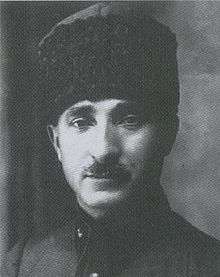Ali İhsan Sâbis
Ali İhsan Sâbis (1882 – 9 December 1957) was the commander for the Sixth Army of the Ottoman Empire.[2] After the war he was exiled to Malta by the British occupation forces. After returning to Turkey, he was appointed to the commandship of the First Army of Turkey. But shortly before the battle of Dumlupınar, he retired.
 Ali Ihsan Bey | |
| Born | 1882 Constantinople (Istanbul), Ottoman Empire |
| Died | December 9, 1957 (aged 74–75) Istanbul, Turkey |
| Buried | Zincirlikuyu Mezarlığı |
| Allegiance | |
| Years of service | Ottoman: 1902–1919 Turkey: September 25, 1921 – June 22, 1922 |
| Rank | Orgeneral |
| Commands held | 1st division of the General headquarters, Chief of Staff of the Second Army, XIII Corps (deputy), General Reserve of the Third Army, XI Corps (deputy), 1st Expeditionary Force, IX Corps, XIII Corps, IV Corps, Sixth Army First Army |
| Battles/wars | Balkan Wars First World War War of Independence |
| Other work | Member of the GNAT (Afyonkarahisar) |
World War I

In 1918, his army was defeated by the joint British-Indian armies and he surrendered the remains of the 6th Army in October 1918 at the Battle of Sharqat, allowing the British to occupy Mosul which was in violation to the Moudros Armistice signed between the British and Ottoman Empires a few days earlier.
Armenian Genocide
Ali Ihsan is also known for his role in the Armenian Genocide. While carrying his duties as commander of the 51st division, the Armenians that belonged to those units were murdered outright.[3] When he took command of the 4th army, Ali Ihsan played a crucial role in the forceful exhaustion and starvation of Armenians, which accounted for the lives of tens and thousands.[3] According to the German foreign ministry:
General A. Ihsan countless times and purposefully let the Germans know that he would not allow a single Armenian stay alive in his command zone. He bragged to German officers that "he had killed Armenians with his own hands" (rühmte sich mit eigener Hand Armenier getötet zu haben).[3][4]
Ali Ihsan Sabis was appointed the head of the 6th army and was tasked to enter Iran where he besieged the Armenian contingents in the area who were led by General Andranik Ozanian.[5] He had also warned the local chieftains that they would be killed if Armenian refugees were hiding under their protection.[6] Proceeding with massacring the local Armenian population, Ihsan confessed in front of a delegation of Armenians in Tabriz on 11 August:
I thank you for having come out to greet me, but listen to what I am going to tell you: above all, prove the truth of your words by your deeds. You are not unaware of all the afflictions that the Armenians of Urmia, Salmast, and Khoy have brought down upon the Muslims...In retaliation, we killed the Armenians of Khoy and I gave the order to massacre the Armenians of Maku. If you with to be well treated, honor the promises that you have just made. If you do not, I cannot offer you any guarantees.[5]
This speech was affirmed by the archives of the French foreign ministry which states:
Ali Ihsan Paşa, formerly the Commander of the Army Corps stationed at Van, entered Tabriz at the end of June 1918 in the capacity of Commander-in-Chief of the Ottoman Forces in Azerbaijan...In an address to an Armenian delegation he said approximately the following: "Let it be known that during my entry into Khoi I had the Armenians of the area massacred, without distinction of age and sex ..."[3]
During a reception of the Armenian Prelate Mgr. Nerses, Ali Ihsan told him: "I had a half a million of your coreligionists massacred. I can offer you a cup of tea."[3][6]
See also
References
- T.C. Genelkurmay Harp Tarihi Başkanlığı Yayınları, Türk İstiklâl Harbine Katılan Tümen ve Daha Üst Kademelerdeki Komutanların Biyografileri, Genkurmay Başkanlığı Basımevi, Ankara, 1972, p. 144. (in Turkish)
- Mango, Andrew (1999). Atatürk: The Biography of the Founder of Modern Turkey. Woodstock, NY: The Overlook Press. p. 191. ISBN 1-58567-011-1.
- Dadrian, Vahakn N. (1995). The history of the Armenian genocide : ethnic conflict from the Balkans to Anatolia to the Caucasus (3rd rev. ed.). Providence, RI: Berghahn. ISBN 1571810161.
- Akçam, Taner (2007). A shameful act : the Armenian genocide and the question of Turkish responsibility (1st Holt pbk. ed.). New York, NY: Metropolitan Books/Holt. ISBN 080508665X. - Profile at Google Books
- Kévorkian, Raymond H. (2010). The Armenian genocide : a complete history (Reprinted. ed.). London: I. B. Tauris. ISBN 1848855613.
- Kévorkian, Raymond H. (2006). Le génocide des Arméniens (in French). Paris: Jacob. pp. 870–1. ISBN 2738118305.
External links
![]()